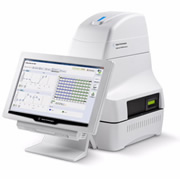
Advantages of this technology
- The two major metabolic pathways are measured simultaneously and in real-time.
- Experiments are performed with living cells in multi-well plates.
- A large variety of cell types can be analyzed: primary cells, established cell lines, spheroids, isolated mitochondria, and small tissue pieces.
- The cells and plates are not affected by the measurements and may be used for additional assays.
- Experiments can be performed using adherent or suspension cells (suspension cells require an additional attachment step).
- Only a small number of cells is required (4,000 – 500,000 per well).
- Measurements can be repeated multiple times for kinetic analysis.
- Measurements can be taken for minutes, hours, or even days.
- The technology is completely non-invasive and does not require the addition of dyes, labels or reporters.
- Up to four test compounds (drugs or substrates) can be added automatically to each well, and measurements are taken before and after addition of the substance.
- The software required for analysis is free (available for PCs only).
- Average instrument run time is 3-5 hours.
More about the Seahorse Technology
The Agilent Seahorse analyzers utilize patented transient micro-chambers and embedded fluorophores to make rapid, sensitive, and precise metabolic measurements in real time. The key to the XF assays is the disposable assay kit, which consists of a cell culture plate and a disposable biosensor cartridge. Cells (or other samples) are plated in the cell culture plate and the sensor cartridge is placed above it, then both are inserted into the instrument. Two fluorophores embedded in polymer at the bottom of the cartridge sleeve function as biosensors. One fluorophore is quenched by oxygen and measures mitochondrial metabolism, while the other fluorophore is sensitive to protons and indicates glycolysis. Fiber optic bundles are simultaneously lowered into each cartridge sleeve and emit light, resulting in excitation of the embedded fluorophores. Changes in fluorescence emission due to alterations in oxygen and proton levels are then detected by the sensors.
The rapid, real time measurements are made possible because the fiber optic bundles are lowered to 200 µm above the cell layer. This creates a transient micro-chamber and allows for immediate measurements. Once the sensors detect a 10% change in oxygen or a similar change in proton levels, the sensors rise and the cells are restored to normal levels. This process can be repeated many times to generate kinetic data. In addition, more data can be collected after the addition of up to 4 compounds directly into the well. Measurements can be taken before and after the injection of inhibitors, stimulators, and substrates to gain more knowledge about the metabolic pathways.
Instrument usage
A mandatory training session is required before an operator is allowed to use the instrument. An initial meeting is scheduled to discuss the various steps involved in setting up/running an experiment as well as the objectives of the experiment. General information will be provided by email in advance, and the initial meeting takes approximately one hour. The training fee includes the initial consultation and the instrument fee for the first experiment. For questions about the instrument or to set up a meeting, please contact Dr. Yue Guan.
Fees
- Training Fee: $100
- Cost per experiment (per day): $100
- Consumables
- XFe96 Flux packs are sold individually at the CIC (when available). This includes a disposable sensor cartridge, cell culture microplate, calibration plate, and XF calibrant. $75.00
- Seahorse consumable items can be ordered through the Genomics Technology Core.
Useful links
- Information and videos (at bottom of the page) about the Seahorse XFe96 Analyzer
- Seahorse XF Technology Cell Metabolism Applications
- Consumables for the XFe96 Analyzer
- Seahorse Cell Reference Database to search scientific publications that reference/cite Seahorse XF data
- Publications with Agilent Seahorse XF Data
- Seahorse XF Software